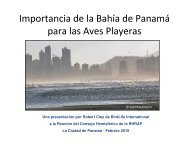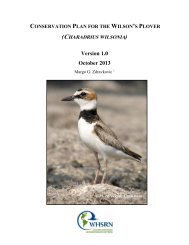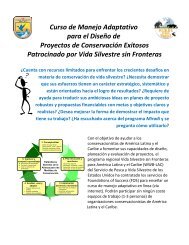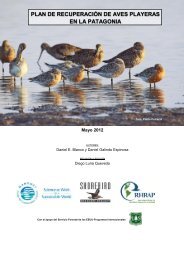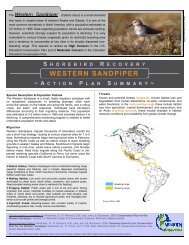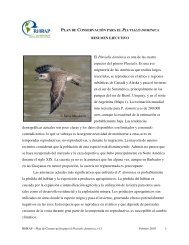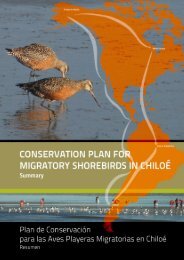Sanderling Plan - Western Hemisphere Shorebird Reserve Network
Sanderling Plan - Western Hemisphere Shorebird Reserve Network
Sanderling Plan - Western Hemisphere Shorebird Reserve Network
You also want an ePaper? Increase the reach of your titles
YUMPU automatically turns print PDFs into web optimized ePapers that Google loves.
humans recreate on beaches, people and dogs are a potentially significant source of disturbance<br />
to <strong>Sanderling</strong>s. Unleashed dogs (and some people) may enthusiastically chase flocks of<br />
shorebirds; while this and other disturbances vary from periodic to continual, day after day (and<br />
cumulatively) they translate into reduced feeding and resting time for <strong>Sanderling</strong>s. The energetic<br />
requirements of migration are substantial, and the energy that <strong>Sanderling</strong>s expend to continually<br />
flee from humans and dogs, combined with the simultaneous loss of opportunity for feeding or<br />
resting, may result in reduced fitness overall for <strong>Sanderling</strong>s.<br />
Several studies have quantified these impacts. In Plymouth Beach, Massachusetts,<br />
vehicular traffic reduced the use of this important staging area (for sandpipers) by up to 50%,<br />
and increased human and vehicle disturbance led to a shift in roost sites or to departure<br />
altogether (Pfister et al. 1992). On Virginia beaches, increased human activity levels translated<br />
into increased time spent flying (or in maintenance behaviors) and less time roosting; <strong>Sanderling</strong><br />
abundance declined with increasing off-road vehicle abundance (K. Forgues, unpubl. data). In<br />
Florida during winter, as beaches became more crowded with people, <strong>Sanderling</strong>s’ foraging time<br />
decreased, and birds moved to areas with fewer people and/or foraged more at night (Burger and<br />
Gochfeld 1991). These and other studies (e.g., Klein et al. 1995, Roberts and Evans 1993, Burger<br />
and Gochfeld 1991, Thomas et al. 2003) indicate that at sites where shorebirds are heavily<br />
disturbed by humans, shorebirds spend less time foraging and resting, with potentially substantial<br />
energetic costs. Specifically, reduced feeding and resting could result in lower energy stores (i.e.,<br />
reduced lipid deposition), potentially interfering with the ability to migrate, with subsequent<br />
breeding success, and possibly even with survival.<br />
Other obvious forms of disturbance include personal motorized watercraft such as jet<br />
skis, which have been shown to disturb roosting shorebirds in Washington (see Buchanan 2000).<br />
However, such disturbances could be greatly reduced by employing buffer distances such as<br />
those determined for other shorebirds (e.g., a minimum distance of between 80–100 meters from<br />
motorized watercraft; Rodgers and Schwikert 2002). Even quiet forms of recreation such as<br />
kayaking, kite-surfing, windsurfing, wave surfing, or fishing can cause disturbance to<br />
<strong>Sanderling</strong>s. These activities usually require associated disruptions such as driving vehicles<br />
along beaches, rigging or assembling equipment (poles/boards/boats) near the water,<br />
entering/exiting the ocean, and recreating near the shoreline (either on land or in water).<br />
WHSRN – <strong>Sanderling</strong> Conservation <strong>Plan</strong>, February 2010, v1.1 41




